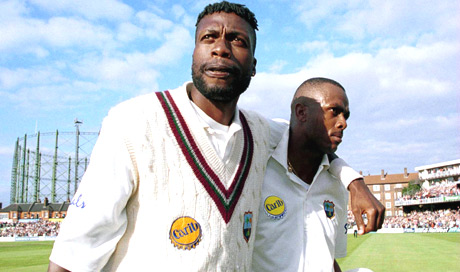Lawrence Booth: A tale of modern bowling decline
March 4th, 2009 by Lawrence Booth in Miscellaneous, Test cricket and tagged cricket, lawrence booth, the wisden cricketer
Quiz question: what happened in both the Karachi and Barbados Tests recently that had – so I’m told – never happened before? Answer: the team batting first made over 600 but still trailed on first innings. Yep, it’s one for the stattos all right, but there is something else going on here. Just where have all the bowlers gone?
I’m indebted here to a colleague from the Guardian, who wandered over from the news desk during the Bridgetown bore-a-thon to point out that Sky had just flashed up the latest ICC Test bowling rankings. “Compare that list to the one 10 years ago,” he suggested. So I did. The comparison proved melodious, but only to those who regard evidence of civilisation’s decline as music to the ears.
Here’s today’s top 10: 1 Muralitharan 2 Steyn 3 Johnson 4 Clark 5 Ntini 6 Harbhajan Singh 7 Taylor 8 Vaas 9 Lee 10 Sidebottom.
And here’s the top 10 in March 1999: 1 Donald 2 Ambrose 3 Pollock 4 McGrath 5 Muralitharan 6 Kumble 7 Doull 8 Wasim Akram 9 Walsh 10 Streak.
What strikes is you not just the fact that Muttiah Muralitharan had five bowlers ahead of him back then and none now, but the calibre of the names. The 2009 list includes three crocks (Stuart Clark, Brett Lee and – yes – Ryan Sidebottom), a once-great left-armer who has taken one Test five-for in four years (Chaminda Vaas), and Jerome Taylor, who is getting better all the time but whose Test average is still 34. These are not names to conjure with.
By contrast, the 1999 list reads like a who’s who of modern bowling giants, with the possible exception of New Zealand’s steadfast Simon Doull and the under-rated Heath Streak, who would be higher than 10th today. The other eight took an average Test haul of 505 wickets (and Murali is still going). Shane Warne doesn’t even make the list; nor does Waqar Younis.
In that sense, the juxtaposition is unfair: most eras would pale in comparison next to the late 1990s. But the strength in depth of today’s bowling would be considered weak in any age. Who, after all, is missing from that list? Ishant Sharma should qualify at some point and Zaheer Khan is close. Shoaib Akhtar is past it. Shane Bond is a victim of politics. Andrew Flintoff doesn’t take enough wickets. Ajantha Mendis is an exciting work in progress. And that’s about it.
Flat pitches are bad enough at the best of times. These are not the best of times. And since Pakistani bowlers are not going to get the chance to hone their reverse-swing skills in home Tests for a while to come, they are not likely to get much better any time soon.
Lawrence Booth writes on cricket for the Guardian. His third book, Cricket, Lovely Cricket? An Addict’s Guide to the World’s Most Exasperating Game is out now published by Yellow Jersey
Posted in Miscellaneous, Test cricket | 4 Comments »


March 5th, 2009 at 3:04 pm
I haven’t seen any convincing explanation for this apparent decline in bowling - but the most likely explanation is that the balance between bat and ball is always changeing and batting is currently ascendent so the bowlers appear worse.
The laws of cricket have been in the past, and now again need to be, adjusted to rebalance the situation.
And this can’t happen quickly enough for my liking. I found the Barbados test last week excruciatingly dull. I am going off test matches in which the scores are huge and the only wins come from random factors like batting collapses, concentration lapses and bad umpiring.
We need to get test cricket to a state when 90 percent of matches end in a result within 3-4 days - and a draw is an unusual novelty.
But the changes would need to be such that bowling skill is rewarded - staging matches on uneven surfaces would not be the answer.
So what should be done? Narrower bat, wider wicket, new ball available every five overs? Make it easier to get LBW decisions (eg for balles pitched outside leg stump). Let’s experiment…
But something needs to be done, and quick.
March 5th, 2009 at 3:28 pm
Pace in the pitch. That’s all that is needed. Then bowlers have a chance, batsmen score runs quickly when set, the game moves forward quickly and even with big scores, you get a result.
March 5th, 2009 at 10:30 pm
Ten years ago we still had cricket provided by a national broadcaster (BBC) who did not request 5 days of action. Advertising rules the roost - and perhaps the need to guarantee 5 days of play is greater than the need to entertain for 3.5 days.
I’m still amazed that a football pitch can last for 5 days (Antigua) after theoriginal abandonment.
On the day that the match was abandoned I picked up my monthly wisden Cricketer - and read that Cardiff has solved its water logged outfield probelm…… by laying a 75% sand outfield.
come the first Ashes Test, any odds on an Antiguan repeat?
March 10th, 2009 at 10:24 am
And then there are the bats. Great hunks of wood that allow even lower order batsmen to look like batsmen. Is Mitchell Johnson really a borderlkine allrounder? Or has he just got a big bat and a solid temprament?